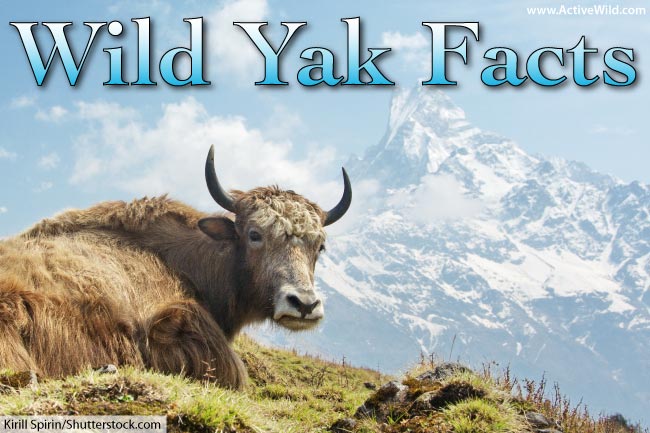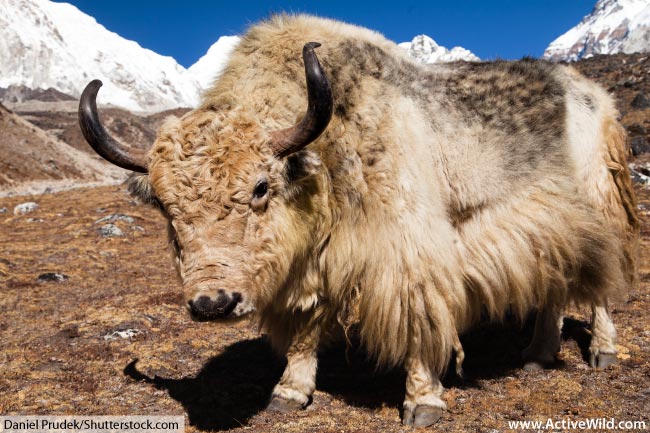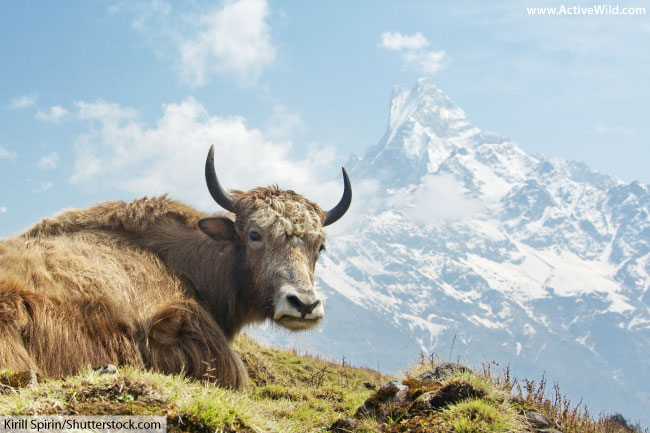Wild yak facts for kids and adults, with pictures and video. The wild yak is a bovid – a member of the cattle family, Bovidae. It lives on the Tibetan Plateau, a region sometimes called the ‘roof of the world’, due to its being over 3 miles (4.8 km) above sea level.
This tundra animal is a cold weather, high-altitude specialist, and has a number of adaptations for living in this hostile environment. Let's find out more about this amazing survival expert...
Wild Yak Facts At A Glance
- Scientific name: Bos mutus
- Type of Animal: Mammal
- Animal Family: Bovidae
- Where Found: Central and East Asia
- Head-Body Length: 2.5 to 3.3 m (8.2 to 11 ft)
- Tail Length: 60 to 100 cm (24 to 39 in)
- Shoulder Height: 1.6 to 2.2 m (5.2 to 7.2 ft)
- Weight: 300 to 1,000 kg (660 to 2,200 lb)
- Conservation Status: Vulnerable
Meet The Wild Yak: Introduction
The wild yak is a large bovid* native to Central and East Asia. It is the ancestor of the smaller, domestic yak (Bos grunniens). The two are considered different species and are thought to have diverged at some point between 1 and 5 million years ago.
* A bovid is a member of the family Bovidae. Members of this family include cattle, sheep, goats, antelopes, and buffaloes. Bovids are hooved animals in the order Artiodactyla, a group of animals otherwise known as ‘even-toed ungulates’. You can find out more about the various animal groups on this page: Animal Classification
What Does The Wild Yak Look Like?
The wild yak is one of the largest bovids. It has a bulky frame, humped shoulders, a broad head, relatively short, stocky legs, and a long, bushy tail. Both males and females have long, upwards-curving horns. The female is around one third the size of the male.
The wild yak is well-insulated with long, shaggy fur that covers the legs and the undersides and a dense undercoat. Typically, the wild yak is dark brown or black in color, but golden-brown individuals have been reported. The muzzle is commonly a grayish color.
Distribution
The wild yak occurs primarily in northern Tibet and the western parts of the northwestern Chinese province of Qinghai.
You can see these areas on the interactive map below:
The species can also be found in southern Xinjiang, northwest China and in Ladakh, India. Small, isolated populations also exist in western Tibet and eastern Qinghai.
Historically, the wild yak's distribution range covered most of the Tibetan plateau (a large area of elevated land in Central and East Asia). Today the species survives only in the more remote parts of the region and is believed to be extinct in Nepal and Bhutan.
Habitat
The wild yak mainly inhabits treeless upland areas of the Tibetan plateau. These include grasslands, cold desert regions, hills, and mountains between 3,000 to 5,500 m (9,800 to 18,000 ft) above sea level.
Most commonly, the wild yak is found in alpine tundra with a thick cover of grasses and sedges (plants similar to grasses).
Typically, the wild yak avoids warm areas and will migrate to higher elevations during the warmest months of the year (August and September). In the winter it will descend once again to the lower valleys.
Wild Yak Adaptations
The wild yak has several adaptations that allow it to survive in a cold environment.
Having a relatively small surface area in comparison to its body weight helps the wild yak to conserve valuable heat. Other adaptations for the cold include having a small number of sweat glands, a long, thick outer coat and a dense undercoat.
A true cold weather specialist, the wild yak can tolerate severe snowstorms and temperatures below −40 °C (104 °F).
The wild yak also has a number of adaptations for living in mountainous regions. Its large lung capacity, combined with blood that contains a high number of small red blood cells (themselves with a high concentration of the oxygen-transporting protein haemoglobin) allow the yak to get enough oxygen from the thin air found at high altitudes.
Strong legs, and hooves that have thin, sharp tips, help the wild yak move with ease along steep, rocky slopes as well as on marshy or snowy ground.
Life In A Herd
The wild yak is a sociable animal. It typically lives in herds that can contain several hundred individuals, although smaller groups of 10 to 20 individuals are also common.
The larger herds comprise females and their young together with a smaller number of bulls. Older males are often found either alone or in small all-male herds numbering 2 to 5 individuals. The male-only herds are typically found at lower altitudes.
Breeding
The wild yak mates in September. After a gestation period of about 260 days, a single calf is born. The calves are able to stand within moments of birth and begin to walk after a couple of hours.
Female yaks usually give birth every other year despite their young being weaned at around 1 year of age.
What Do Wild Yaks Eat?
The wild yak is a herbivore (plant-eater). It mainly eats grasses and sedges, although its diet also includes smaller quantities of herbs, shrubs, mosses, tubers and lichens. During the winter, the wild yak obtains water by eating snow and ice.
Feeding usually occurs during the morning and evening. Yaks may have to travel long distances in search of food due to the scarcity of vegetation in their typical habitats.
Predators
The main natural predator of the wild yak is the Tibetan wolf (Canis lupus filchneri), a subspecies of gray wolf. In some regions, there have also been reports of snow leopards (Panthera uncia) and brown bears (Ursus arctos) preying on wild yaks.
The wild yak will readily flee from danger, often seeking safety on steep slopes. A herd of wild yaks may also defend itself from predators by huddling in a circle with horns lowered.
Is The Wild Yak Endangered?
The wild yak is rated 'Vulnerable' by the IUCN.
When assessed in 2008, the world population of wild yaks was estimated to be less than 10,000. It is believed that the population has continued to decline.
The main threats to the wild yak include:
- Hunting: Illegal hunting for wild yak meat and horns poses the most serious threat to the species. Wild yaks are targeted by both casual and commercial hunters, and the remoteness of the areas in which the species is found makes it difficult to enforce laws prohibiting hunting.
- Competition with livestock: The spread of pastoralists (livestock farmers) and their domestic animals into previously uninhabited areas has pushed wild yaks out of many of their former grazing lands. Occasional interbreeding with domestic yaks is also considered a threat to the species.
Wild Yak Facts: Related Pages On Active Wild
- Find amazing species from all around the world: A to Z Animals
- Become an animal expert!: Animals: The Ultimate Guide To The Animal Kingdom






